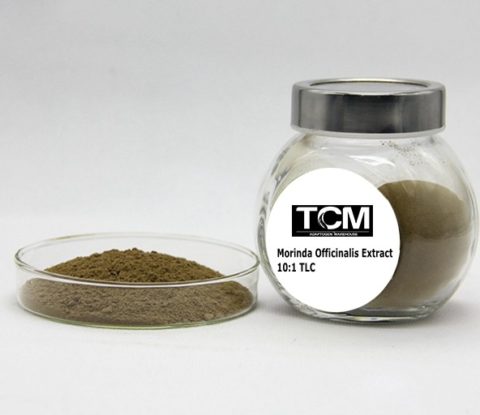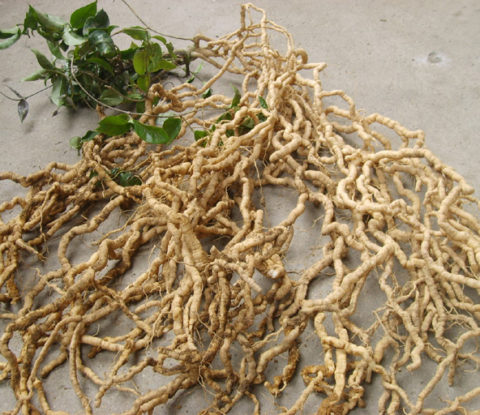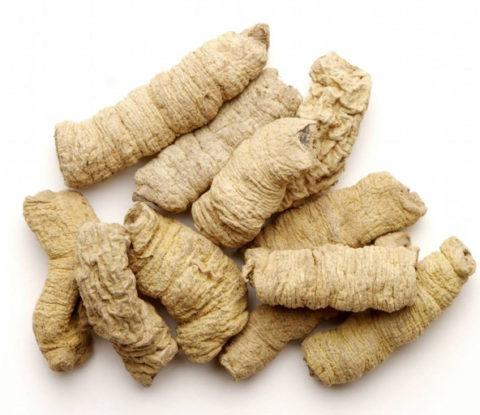
Morinda Officinalis Extract
【Botanical source】: Morinda officinalis How.
【Other names】: Ba Ji Tian, Ba Ji, Medicinal Indianmulberry Root, Radix Morindae Officinalis
【Part of used】: root
【Specification】: 10:1, 20:1
【Test Method】: TLC
【Appearance】: Yellow brown fine powder
【Function】: Men health promotor
【Origin】: The root of the vine bush plants Morinda officinalis How. of family Madder.
【Location】: Mainly produced in Guangdong, Guangxi and Fujian provinces in China.
General Information
Vine-like shrubs. Root succulent hypertrophy, cylindrical, irregular and intermittent swelling, with a rosary. A thin vertical stems of the Prism, childhood was brown coarse wool. Leaves grows crossing; petiole 4-8 mm long, brown Coarse; long oval leaves, 3-13 cm long, 1.5-5 cm wide, short tip gradually sharp or blunt circular base, the entire margin above dark green, often with Tenderness canthus color, and a short value infrequent coarse wool old small slippery when no hair, along the vein below on the short thick hairs, leaf edge short lashes, side 6-7 on the clock; membranaceous, sheath-like. Inflorescence first-shaped,2-10, was born in the top of branchlets Power Plant into umbrella or inflorescence; the pedicel of 3-10 mm, the sewage Brevibacterium Coarse; inverted cone-shaped calyx, a tip irregular teeth crack; Corolla white, succulent, up to 7 mm long, and the corolla throat of the contraction in the face of short Coarse, the majority of three deep crack, crack 14 less; stamen and the same number of flowers segment. Born in the corolla tube near the base, filament short of the ovary, Room 4, style slim, 2 deep crack, possession of the Corolla. Stone nearly spherical diameter of 6-11 mm, red when cooked. There are small nuclear 4 seed, nearly oval or inverted oval, back uplift, flat side, Sophie was white short hair. Flowering period from April to July,fruit august.
A commonly used tonic herb in Chinese herbal treatments, Ba Ji Tian, or morinda root in English, is so popular probably because of its special relationship with kidney, an organ linking so closely to libido in Traditional Chinese medicine (TCM) theory. Kidney is more than just a common organ in this level and herbalists tend to believe that this important Zu-Fu is intimately related to im-potenc-e, infertility and other reproductive health matters. For better understanding of how this herb functions, the concept of kidney in TCM will be the first problem to work.
Before going further, it is a good idea to explore the notion of kidney at the Traditional Chinese Medicine level now. Kidney, in the shape of a bean, is one of internal organs of the urinary system in Western medicine, which flanks L1 to L3 lumbar vertebrae. It is in charge of secreting and excreting urine and regulate body fluid metabolism. If there is something wrong with kidney, normally organic lesions is involved, such as glomerulonephritis, pyelonephritis, kidney stone, and renal tuberculosis, etc.
Kidney in TCM, however, is quite different. The understanding of kidney pathophysiology is beyond itself from this angle. It is more and broader. For instance, the pyelonephritis may present different patterns in TCM’s eye, which could be kidney Yin or Yang, and kidney excess or deficiency. Based on the different presentations, different herbal remedies might be applied.
Given the above reason, practitioners believe that kidney functions on a few vital jobs like storing the essence, controlling bone, promoting urination and bowel movements, supervising the growth and development, and managing s-exual reproduction besides of regulating body fluid metabolism.
Chemical compositions
Identified active ingredients include: Rubiadin, rubiadin-1-methyl-ether, methyl-ether from Radix et Rhizoma Rhei, monotropein, tetraacetylasperuloside, β-sitosterol, palmitic acid, nonadecalkane and dimethyl-alkane. Radix Morindae Officinalis also contains monosaccharides, polysaccharides, resin, vitamin C, 11 free amino acids and 17 amino acid hydrolysates. The cortex of Radix Morindae Officinalis (pic.a) contains reducing sugars and glycosides, cardiac glycosides, flavones, triterpenoid steroids, amino acids, organic acids, micro-anthraquinone and metal elements. More abundant microelements include potassium (K), calcium (Ca) and magnesium (Mg). The lead content in the cortex is lower than in the root core (pic.b). Other elements like iron (Fe), manganese (Mn), zinc (Zn) and 16 others are higher in the cortex than in the root core.
Indications in Traditional Chinese Medicine
1. Deficiency of kidney yang
It is indicated for im-potence, seminal emission, sterility due to cold in womb, frequent urination, cold and pain in lumbar and knees and other symptoms caused by kidney yang deficiency, because it can tonify kidney yang, strengthen tendons and bones, and it is warm and sweet without dryness in properties. For it is mild in actions of tonifying kidney yang, it is combined with other herbs to tonify. For im-potence and sterility due to kidney yang deficiency, insufficiency of fire of life gate, it is combined with kidney-yang-tonifying and kidney-essence-supplementing herbs, for instance, it is used with Yin Yang Huo, Xian Mao, Shu Di Huang and Gou Qi Zi in the formula Zan Yu Wan from Jing Yue Quan Shu. For deficiency cold in lower energizer, sterility due to cold in womb, irregular menstruation and cold-pain in abdomen, it is combined with herbs of warming kidney and liver, dispelling cold and relieving pain, for instance, it is used with Rou Gui and Gao Liang Jiang in the formula Ba Ji Wan from Tai Ping Hui Min He Ji Ju Fang.
2. Wind-damp arthralgia
It is very suitable for chronic arthralgia, weak tendons and bones due to the disease affecting liver and kidney, or kidney yang deficiency with weak tendons and bones attacking by arthralgia, because it can dispel wind-damp, tonify kidney yang, and strengthen tendons and bones. It is commonly combined with herbs of tonifying kidney and liver, strengthening tendons and bones, and dispelling wind-damp. For flaccidity of bones, soreness and limpness of lumbar and knees, it is combined with Du Zhong, Rou Cong Rong, Tu Si Zi and Bi Xie in the formula Jin Gang Wan from Zhang Shi Yi Tong. For excessive inner cold-damp, atrophy-flaccidity of tendons and bones, cold and pain of lumbar and knees, it is combined with Fu Zi and Niu Xi in the formula Ba Ji Wan from Sheng Hui Fang.
3. Boost immunity and disease resistance capacity
The experimental results show that, Morinda root polysaccharide can increase childhood thymus weight, and markedly increase mouse macrophage phagocytosis percentage of mice and can significantly improve the P-JFC formation. This means morinda root polysaccharide with adrenocorticotropic h-ormone and the role of a build up their strength. Can enhance human immunity, reduce disease.
4. Anti-aging, anti-fatigue, anti-depressions
Study identified: Morinda officinalis extract could significantly increase glucose content of the aged mice brain tissue, increase the rat model of brain aging superoxide dismutase (SOD) and glutathione peroxidase (GSH-Px), Activity increased, decreased lipid peroxidation (LPo) content, retard aging of brain tissue.
Morinda officinalis extract could significantly prolong mice continuous swimming time in the water and increase the time and activity hanging in the online campaign, and also reduce the mice oxygen consumption in a state of hypoxia, increase the duration of hypoxia tolerance. Morinda officinalis increase the body reserving ability,increase fatigue resistance, and increase in the body to stimulate the hypoxic stress,compensatory ability. Study found that from Morinda officinalis extract isolated five monomers shows obvious antidepressant activity.
5. Enhance learning and memory
Morinda officinalis extract can be significantly improved decreased spatial learning and memory in aging rats due to D-lactose, especially space exploration process to highlight that Morinda officinalis extract can enhance learning and memory capacity.






